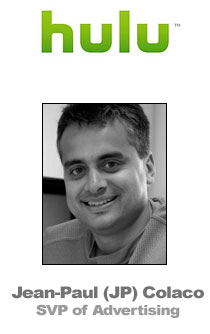 More than any other streaming video joint venture, Hulu has never had to work too hard to resemble the TV experience – thanks to its backers, NBC Universal, News Corp., ABC, it is the primary spot for primetime viewing on the web. But as YouTube continues to build its own more “professional” channel spaces and Netflix is concentrating more on new and old TV fare, Hulu needs to change or see others pass it by.
More than any other streaming video joint venture, Hulu has never had to work too hard to resemble the TV experience – thanks to its backers, NBC Universal, News Corp., ABC, it is the primary spot for primetime viewing on the web. But as YouTube continues to build its own more “professional” channel spaces and Netflix is concentrating more on new and old TV fare, Hulu needs to change or see others pass it by.
In its NewFront presentation (the web industry’s attempt to counter the broadcast upfront period) this morning at the New York Time Center in Manhattan, Hulu, which depends on both advertising and consumer subscription dollars for support, sought to convince media executives that it is at the front of the convergence between broadcast and digital video with a set of originally produced series and an emphasis on smarter ad formats.
In an interview with AdExchanger, Jean-Paul (JP) Colaco, Hulu’s SVP of advertising, discussed the importance of new programming to the site as well as its confidence that it will only charge its advertisers based on a 100 percent completion rate for spots seen.
“For the first couple years, we were testing and learning what the boundaries were in terms of advertising,” Colaco said. “We’re now seeing advertisers more in the space and we can put what we’ve learned to work. That includes the ability to run ads across different platforms – if you’re a game manufacturer, you can just run ads on gaming consoles. Or, if you are more interested in traditional ad formats, you can buy ads strictly on an impression/Gross Ratings Point standard. Conversely, you can buy ads that are targeted to local viewers. We’ve geared this system towards ad effectiveness, and among the things we’ve learned, there is more than one way to get there.”
Among the details Hulu sought to impress attendees at this morning’s NewFront with included:
- Hulu earned $420 million in revenue last year
- Hulu Plus, the $8 a month service for access across smartphones, tablets and connected TVs, had exceeded more than 2 million paid subscribers in Q1 of this year
- Programming is not just from NBC, Fox and ABC: There are more than 360 content partners on Hulu and Hulu Plus.
- As of March 2012, Hulu’s content partners offered approximately 40,000 hours of content on Hulu and Hulu Plus (and growing) and more than 50,000 full TV episodes on Hulu and Hulu Plus
- There are roughly 1,900 TV series on Hulu and Hulu Plus
It has featured ads from over “1,000 brand advertisers” since its debut in March 2007.
In terms of keeping those 1,000 advertisers coming back – Hulu didn’t say how much repeat business it gets – Colaco stressed that flexibility in terms of the options that marketers can avail themselves is the key.
“We want to be able to communicate in a language that advertisers are used to, so if that means offerings GRP-based buys, we are happy to do that,” Colaco said. “But we’re not limited to that. We recognize that we need to experiment with new metrics. But ultimately, it all has to do with a marketers’ needs and goals. The point is that online advertising has to be easy to buy, so if you want GRPs or [Targeted Rating Points], that’s fine too. Also, how you’re counting the reach, effectiveness – the pricing should be related to how effective we are. For example, we won’t charge an advertiser if they ad doesn’t get 100 percent completion. At the same time, delivering someone who’s shown purchase intent is something we should be rewarded on when we deliver that ad.”
In a statement, Rick Hosfield, VP for Content Planning & Distribution at General Mills said: “Hulu’s ability to validate our impressions based on completed views will be of significant interest to us, and ultimately prove to be invaluable for all brand marketers. As a company focused on innovation we are excited to partner with Hulu on this new, 100 percent completion rate model that can minimize waste and maximize effectiveness of video advertising for General Mills Brands.”
On top of offering stronger guarantees, Hulu is now getting deeper into the programming business. Even beyond the matter of competition from Netflix, which is bringing back new episodes of canceled Fox Broadcasting cult favorite Arrested Development, Hulu is also finding itself increasingly squeezed by its backers on running current season favorites (for example, Hulu Plus subscribers who want to watch 30 Rock on their iPads or connected TVs have to rely on their PC only, as the NBCU show is not available on the subscription service).
The four new shows reflect the idea that in order for online video to close the gap with TV in terms of commanding similar CPMs and dollar flow, the web needs to be more original. After all, why pay a premium price for something that is second hand?
The new Hulu-only series include We Got Next, which is centered around four basketball playing friends, The Awesomes, an animated series by “Saturday Night Live” head writer Seth Meyers, Don’t Quit Your Daydream, a documentary about musicians from Entourage star Adrian Grenier, and Flow, a drama about a man framed for a crime he didn’t commit.
“Premium content is really important for several reasons” Colaco said. “We founded the company with a simple mission: provide programming where, when how viewers want to see it. The idea behind Hulu Originals is that there are a number of exciting stories waiting to be told, but not all of them have found the right outlet. We are working closely to develop distinctive stories. If you look at film, Sundance, became the platform for movies that didn’t fit the existing distribution order. Where is the platform for independent TV? That’s us.
“We’re looking for content that will be beloved by audiences of individuals, rather than the masses,” Colaco continued. “We want shows that fans will blog, tweet about and spread by word of mouth. With online video, you’re on demand, it’s about connecting with audiences. The whole is greater than the sum of the parts. That’s what viewers are looking for and that’s what advertisers are looking for.”
By David Kaplan











